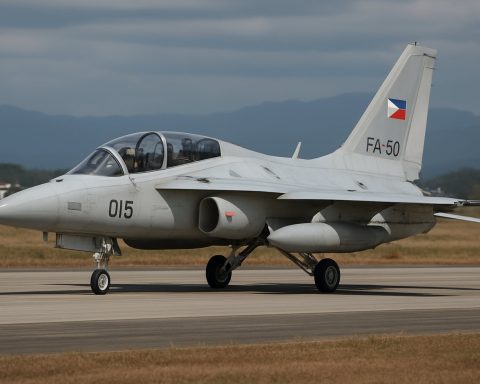- Japan has significantly increased its aerial responses, with fighter jets taking off 30 times in fiscal year 2024 to shadow drones near its southwestern frontier.
- A sevenfold increase in drone-related activity compared to three years ago highlights rising tensions in the Nansei Islands region, a strategic area towards Taiwan.
- China’s sophisticated drones, including the TB-001, BZK-005, and GJ-2 models, represent advanced reconnaissance and attack capabilities.
- The drones’ paths indicate strategic ambitions, challenging Japan’s geographical boundaries and hinting at China’s broader military objectives.
- Heightened activities by China’s navy and coast guard—to assert territorial claims over contested islands—underscore growing geopolitical tensions with Japan.
- Japan regards these maneuvers as threats to regional stability and is bolstering its defense posture alongside allies to counteract China’s assertive claims.
- The situation accentuates the need for vigilance amidst complex international relations and evolving technological challenges.
Piercing through the azure skies of the Pacific Ocean, the quiet hum of drones weaves an intricate ballet in the airspace around Japan’s southwestern frontier. In fiscal year 2024 alone, Japan’s fighter jets took to the air 30 times to shadow these elusive, unmanned visitors—an unprecedented surge in activity that marks a sevenfold increase compared to just three years prior. The celestial stage? The strategic expanse over the Nansei Islands, a key segment of the First Island Chain stretching toward Taiwan, where geopolitical tensions between Beijing and Tokyo hang thick in the air like a summer squall.
These aren’t ordinary drones; they’re sophisticated pilots of advanced reconnaissance and attack capabilities. China’s fleet, ranging from the formidable TB-001 to the stealthier BZK-005 and GJ-2, reveals an overt strategy that transcends mere observation. Their paths carve bold lines across the map, from the waters off Amami Oshima to the skies above Yonaguni Island—a mere heartbeat away from Taiwan.
The drones’ routes reveal a strategic ambition. On a clear June day, a TB-001 navigated the waters between Okinawa and Miyako Island, dipping into the Pacific before arcing north towards Amami Oshima—a first in China’s aerial choreography. This movement wasn’t solitary. Similar pathways were traced soon after by other UAVs in a calculated demonstration of readiness and reach, brushing alongside the geographic boundaries that tether Japan to the tussled edges of Chinese claims.
China’s expanded drone operations came on the heels of increasing activities by the People’s Liberation Army Navy’s aircraft carrier groups and heightened patrols by the China Coast Guard (CCG). As vessels encroach upon the spectral edges of the Senkaku Islands, known as the Diaoyu Islands in China, these waters have become a maritime chessboard—the silent quivering of waves reflecting the weight of centuries-old disputes.
Beijing’s maneuvers underline its unwavering claim that these islands, lapped by the East China Sea, are integral to its territory—a stance it ardently broadcasts while urging Japan to cease its ‘illegal activities.’ Yet, Tokyo stands resolute, interpreting these movements as a challenge not only to national sovereignty but as a broader issue threatening regional stability.
Amidst this aerial and naval shadow play, Japan’s Defense Minister Nakatani Gen voices a heightened alert. His message underscores a stark reality: Japan is not merely a passive spectator on this stage. The country is poised, ready to respond with a strengthened alliance involving its partners and allies. In the dance of international relations, Japan remains acutely aware of the delicate balance required to maintain peace and stability.
The takeaway from these strategic postures high above the ocean and in contested waters below is the enduring importance of vigilance. As technological advancements craft new paradigms of power and influence, the skies above the Pacific Islands serve as a reminder of the delicate threads that weave the tapestry of modern geopolitics.
The Drone Wars: How Japan and China Are Redefining Airspace Security
Insights into Japan and China’s Strategic Drone Operations
The presence of advanced unmanned aerial vehicles (UAVs) in the contentious airspace over the Nansei Islands highlights evolving military strategies in Asia. As Japan scrambles its fighter jets to intercept China’s increasingly sophisticated drones, it reveals a glimpse into the future of warfare marked by high-tech surveillance and asymmetrical power dynamics.
Key Drone Models and Their Capabilities
1. TB-001
– Role: Twin-engine reconnaissance and combat.
– Features: Able to carry multiple types of payloads, making it versatile in both surveillance and offensive operations.
2. BZK-005
– Role: Long-endurance surveillance.
– Features: Known for its stealth capabilities, making it difficult to detect and track.
3. GJ-2
– Role: Combat UAV.
– Features: Equipped with the capability to carry out precision strikes.
These UAVs represent China’s intent to leverage technology for strategic advantage, challenging traditional air defense mechanisms.
Pressing Questions and Expert Insights
Why is the surge in drone activity concerning?
The increase in China’s drone presence is particularly troubling for Japan and its allies due to:
– The potential for drones to conduct electronic warfare and cyber operations, disrupting communications and intelligence networks.
– The dual-capability of these UAVs to perform reconnaissance and attack operations, posing a direct threat to national security.
How is Japan responding?
Japan is enhancing its defensive measures by:
– Increasing the readiness and frequency of air patrols.
– Expanding collaborations with allies, particularly the United States, to enhance regional security frameworks.
Expert analysts suggest that these actions are crucial to deter potential aggression and protect national sovereignty.
Market Forecasts & Industry Trends
The global market for military drones continues to grow, driven largely by increased demand in Asia-Pacific regions:
– Growth Rate: Expected to see a CAGR of over 12% by 2028, largely due to geopolitical tensions and the pursuit of cutting-edge military technology.
– Investment Focus: Nations are investing significantly in AI and ML to improve drone capabilities, emphasizing stealth technology and electronic warfare readiness.
Pros & Cons Overview
Pros:
– Strategic Advantage: Drones provide significant advantages in surveillance and rapid response without risking pilot lives.
– Cost-Effectiveness: UAVs are generally cheaper to produce and operate compared to traditional aircraft.
Cons:
– Security Vulnerabilities: Increasing reliance on drones can raise vulnerability to cyber attacks.
– Escalation Risk: Drones may provoke unintended escalation in tensions due to misinterpretations of actions.
Actionable Recommendations
– Defense Strategy Review: Regularly update and revise defense strategies to incorporate technological advancements and anticipate potential threats.
– International Dialogues: Engage in diplomatic conversations with China to establish mutual UAV usage protocols to prevent accidental conflicts.
In conclusion, as Japan and China navigate through these intricate geopolitical waters, the emphasis remains on strategic vigilance and readiness to foresee possible threats posed by advanced drone technologies.







